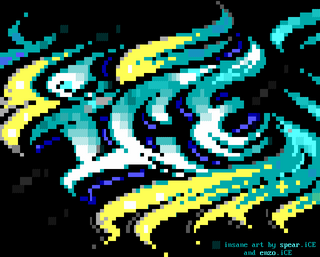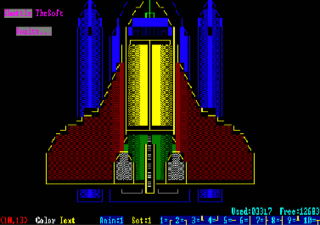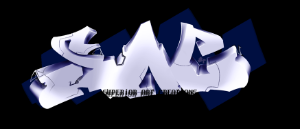Related Research Articles

ASCII art is a graphic design technique that uses computers for presentation and consists of pictures pieced together from the 95 printable characters defined by the ASCII Standard from 1963 and ASCII compliant character sets with proprietary extended characters. The term is also loosely used to refer to text-based visual art in general. ASCII art can be created with any text editor, and is often used with free-form languages. Most examples of ASCII art require a fixed-width font such as Courier for presentation.

The demoscene is an international computer art subculture focused on producing demos: self-contained, sometimes extremely small, computer programs that produce audiovisual presentations. The purpose of a demo is to show off programming, visual art, and musical skills. Demos and other demoscene productions are shared at festivals known as demoparties, voted on by those who attend and released online.
The computer art scene, or simply artscene, is the community interested and active in the creation of computer-based artwork.
ACiD Productions (ACiD) is a digital art group. Founded in 1990, the group originally specialized in ANSI artwork for bulletin board systems (BBS). More recently, they have extended their reach into other graphical media and computer software development. During the BBS-era, their biggest competitor was iCE Advertisements.

Pilgrimage was a demoparty which took place annually in Salt Lake City, Utah each summer between 2003 and 2006. The event was founded by Rich "Legalize" Thompson of the demoscene group Polygony. Pilgrimage was, at the time, the only active demoscene event of its kind in all of North America, while many demoparties take place annually throughout Europe.
ANSI art is a computer art form that was widely used at one time on bulletin board systems. It is similar to ASCII art, but constructed from a larger set of 256 letters, numbers, and symbols — all codes found in IBM code page 437, often referred to as extended ASCII and used in MS-DOS and Unix environments. ANSI art also contains special ANSI escape sequences that color text with the 16 foreground and 8 background colours offered by ANSI.SYS, an MS-DOS device driver loosely based upon the ANSI X3.64 standard for text terminals. Some ANSI artists take advantage of the cursor control sequences within ANSI X3.64 in order to create animations, commonly referred to as ANSImations. ANSI art and text files which incorporate ANSI codes carry the de facto.ANS file extension.

Notacon was an art and technology conference which took place annually in Cleveland, Ohio from 2003 to 2014. Notacon ceased operations in 2014. The name Notacon became a bacronym for Northern Ohio Technological Advancement Conference; however, use of this was mostly dropped after the first year. Notacon preceded the Ingenuity Festival by over a year in its vision for a cohesive blend of art and technology.
An artpack is an archive of computer artwork which is distributed in a compressed format such as ZIP or RAR.

iCE Advertisements is a digital art group founded in Canada by Many Axe in 1991. Although the expanded title is rarely ever used, iCE is an acronym for Insane Creators Enterprise. iCE, along with ACiD Productions, was one of the most prominent and critically successful groups on the underground computer artscene.

TheDraw is a text editor for MS-DOS to create ANSI and animations as well as ASCII art. The editor is especially useful to create or modify files in ANSI format and text documents, which use the graphical characters of the IBM ASCII code pages, because they are not supported by Microsoft Windows anymore. The first version of the editor was developed in 1986 by Ian E. Davis of TheSoft Programming Services. The last public version of the editor was version 4.63, which was released in October 1993.

Superior Art Creations (SAC) is an underground artscene group which caters primarily to and is well known within the warez scene. SAC members have made, besides ANSI and ASCII art, VGA bitmap graphics, tracker music, and a variety of other works. SAC's character graphics have also been used in bottles and FTP servers.

Jason Scott Sadofsky, more commonly known as Jason Scott, is an American archivist, historian of technology, filmmaker, performer, and actor. Scott has been known by the online pseudonyms Sketch, SketchCow, The Slipped Disk, and textfiles. He has been called "the figurehead of the digital archiving world".

Hugi is one of the longest lasting, frequently released demoscene and underground disk magazines (diskmag) for IBM-PC.

Soulz at Zero (SAZ) was a lit group formed in 1994 by Jack Flack and The Stranger. SAZ released 25 monthly packs over a period of two years, beginning in September 1994 and ending in September 1996. The group took its name from a Souls at Zero poster Flack had in his bedroom at the time, with the trailing "s" in "Souls" changed to a "z". Soulz at Zero was so well known that their name was added to the "Elite Acronym List," which was used to separate "lamers" from "elite users."

Creators of Intense Art, or Cia was an underground computer artscene group that primarily released ANSI, ASCII, and high resolution artwork from 1993 to 2001. Along with iCE and ACiD, Cia was one of the most active, and longest lasting groups on the artscene.
Digital Artists of a Rare Kind, later known as Dark Illustrated, or simply Dark was an underground computer artscene group that primarily released ANSI, ASCII, and high resolution artwork from 1994 to 1999. Though the organization did not operate as long as ACiD, iCE, or CiA, Dark was a very influential and critically successful group. Dark was especially popular with Canadian ANSI artists, who made up a large portion of the member base.
Blade, also referred to as The Blade Nation, was an underground computer artscene group that primarily released ANSI, ASCII, and high resolution artwork from 1994 to 1997, and during a brief time in 1998.

Fire, later known as Fire Graphics, was an underground computer artscene group that released ANSI, ASCII, and high resolution artwork from 1994 to 1998.
This is a list of the minor computer underground artscene groups spanning from roughly 1992 to the present day.
Aces of ANSI Art was the first group of artists specifically organized for the purposes of creating and distributing ANSI art. The group was founded and operated by two BBS enthusiasts from California, "Zyphril" and "Chips Ahoy", from 1989 through 1991.
References
- ↑ Jason Scott (2005). "BBS: The Documentary" (DVD). Boston, Massachusetts: Bovine Ignition Systems.
- ↑ Hargadon, Michael A. "Like City Lights, Receding: ANSi Artwork and the Digital Underground, 1985-2000." Concordia University, March 18, 2011. Retrieved October 18, 2011.
- ↑ Jashiin (August 2004). "Exclusive interview with RaD Man (Russian and English)". Tsifra Magazine. Archived from the original on October 17, 2008. Retrieved March 31, 2013.
- ↑ dark+domain: the artpacks.acid.org collection
- ↑ Dark Domain – Defacto2
- ↑ Dark + domain : the artpacks.acid.org collection (Computer file, 2004) [WorldCat.org]
- ↑ Dark Domain: the artpacks.acid.org collection. San Jose, California: ACiD Productions. 2003. ISBN 0-9746537-0-5.
- ↑ The ARTS :: Artscene Radio Talk Show
- ↑ Caballero, Enrique (August 29, 2004). "Pilgrimage Inc Interview - Pilgrimage Demo Party 2004". 3DLUVR. Archived from the original on February 4, 2012. Retrieved March 31, 2013.
- ↑ "Pilgrimage website". Pilgrimage, Inc. Archived from the original on March 5, 2005. Retrieved 2013-03-31.
- ↑ CULT OF THE DEAD COW: Brand New NSFer & HAWT NEW musical release!!!
- ↑ Polaris (April 2007). "Interview with Jason Scott and RaD Man". Hugi Magazine Issue 33. Retrieved March 31, 2013.
- ↑ "Blocktronics website". Blocktronics. Archived from the original on 2009-10-22. Retrieved 2013-03-31.